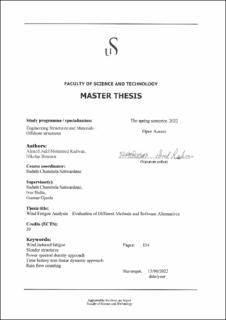| dc.description.abstract | Wind induced fatigue damage affects most slender structures such as flare booms and bridges in offshore environment. Due to the irregular and dynamic nature of wind, wind loading might cause structures to vibrate near the structure’s natural frequency. Even though a structure never experience wind loading over the ultimate limit, vibrations can cause micro plastic deformities such as micro cracks, that over time can lead to fatigue-induced failure. The process of fatigue is complex in nature and hard to estimate accurately. A widely used approach in the offshore industry for calculating fatigue induced damage on complex structures is the use of FEM models and annual probability of wind speed and directional data. Two design methods for estimating fatigue damage are used: the spectral density approach and time history non-linear dynamic analysis. Both methods are based on the hot spot stress assessment approach.
FRAMEWORK and WINDPACK are software which uses the spectral density approach, and USFOS can be used to perform a non-linear dynamic analysis. The time history approach is slightly more computationally demanding to set up; however, it is arguably more accurate. Time history analysis offers more control, since each load case can be analyzed and verified separately, whereas the spectral transforms all load history into spectral diagrams. The spectral equations however are well documented and based on site collected wind turbulence data. There is research demand for further development of both methods, mainly for confirmation with real structural behavior. However, since spectral approaches are generally less demanding, comparing the two methods is also of interest for the practicing industry.
The main objective of this thesis is to compare the results and parametric sensitivity of the three different software using the two methods of fatigue calculation, due to wind buffeting. The effect of vortex induced vibrations on individual members are not included in this thesis.
Multiple fatigue analyses of a typical flare tower in the North Sea (Flare 1) are done with the same FEM model, with as similar input as possible, for all three software. Parametric studies have been executed for the following parameters: weight factor, drag coefficient (Cd), wind block combination and relative velocity. Time increment effect has also been studied in USFOS but is not considered as a parameter as it is a case dependent. The results from different parameter cases have been stored for the 5 most critical joints, and graphs are plotted to study trends.
Before the main comparisons are made, the thesis goes through the reasoning behind certain parameter choices. Then all software results are presented separately to illustrate how different parameter affect fatigue life, then comparisons between the software and the spectral density method against time history method is presented.
The main findings of this thesis are that USFOS predicts on average 66% the fatigue life that FRAMEWORK finds. For weight factor 1.0 cases, the difference becomes 49%. FRAMEWORK predicts on average 41% of the fatigue life that WINDPACK predicts. FRAMEWORK seems to be rather sensitive to weight factor change in the range of 1.0 to 1.1, which does not correlate with the change in the same range in the other two software. | |
